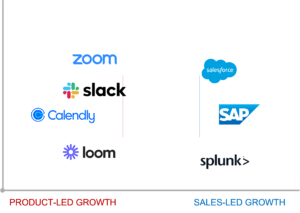Home > Blog > 50 Shades of Product-Led Growth
50 Shades of Product-Led Growth

With the phrase “product-led growth” popping up so often in business conversations these days, you’d think we would all have a shared understanding of what the concept means. But I’ve heard and read the product-led approach described differently many times. That’s unfortunate, and here’s why.
I’m seeing a lot of product teams get overwhelmed and lost in the details of the product-led growth (PLG) approach. And the fact that PLG generally describes strategies taken by SaaS companies also creates a second challenge. Many organizations in other industries assume the framework is not relevant for their products.
The truth is, employing the principles of PLG can create massive benefits for both your company and your customers—regardless of your industry or the types of products you build.
In fact, before we get into the specifics of how you can add product-led tactics to your growth strategy, let me first note that your instincts in seeking out a post like this are spot-on: PLG can definitely add value to your product. And regardless of where you are right now on the PLG continuum, if you’re interested in trying this approach, you’ll find lots of good news in this blog.
What Is Product-Led Growth?
It’s a strategy that leverages the product itself to drive growth.
The good news is that PLG is much less complicated than many people think. For our working definition, let’s turn to the folks that originated the term. When the venture capital firm OpenView coined the phrase product-led growth, here’s how they defined it:
Product-led growth:
“A growth model where product usage drives customer acquisition, retention, and expansion.”
— OpenView Partners
Why Is PLG Important?
It has proven highly useful in driving product success.
It’s worth learning about PLG because this approach has helped so many businesses across so many industries cost-effectively grow their user base, market share, and revenue.
And as you can infer from the definition above, PLG does not need to be an either-or decision for your company. You can build PLG elements into your products or processes while also leveraging the benefits of a traditional sales-led model.
In fact, one of the most important principles I hope you take away from this post is that PLG is a flexible framework that you can customize around your product, user persona, company culture, and existing sales model. Think of PLG as an additional tool in your sales toolbox.
What PLG Is Not?
Here’s where we find a lot of the misconceptions about PLG—misconceptions that unfortunately keep many product organizations from pursuing this approach when it could help them tremendously. As you read through this list, I think you’ll see that there are many more opportunities than you might have realized for your company to benefit from PLG.
It’s not a binary option; it exists on a continuum.
I love looking at the characteristics of things on a continuum, not as binary choices. I apply this both to my views of people’s personality traits and to my work leading a company. In the same way that a person is not just kind or just mean, companies and products are not necessarily PLG or not. In fact, many of the companies in the PLG hall of fame are probably not “pure” PLG companies anymore.
So let’s make some sense of this. On one side of the continuum, you have PLG companies; on the other, sales-led growth (SLG) companies; and in the middle, well, everything else. To give a few examples of iconic products on each side of the fence:

Note that the (predominantly) SLG companies here—Salesforce, SAP, and Splunk—are not exactly companies with market share, revenue, or growth numbers to be ashamed of.
It’s not one thing; it’s a flexible list of choices.
I think a lot of the confusion over this concept originates when people become fixated on one specific component of PLG—and there are many.
Some businesses assume product-led means building products that benefit from the network effect, where users eagerly recruit more users because doing so makes the product more valuable for them. Others think of PLG as designing products with the end user in mind. Still others understand the concept to mean giving the product, or some portion of the product, away for free.
Every one of these notions is correct. They’re all part of the PLG approach because each meets our working definition of product-led: Usage of your product fuels the company’s growth.
Here are just some of PLG’s many elements that you can pick and choose from, depending on what strategies suit your company, product, and customer:
- Build the product to serve as its own sale and distribution vehicle.
- Build in a “network effect,” where the product encourages users to recruit more users because doing so makes it more valuable for everyone. (Think Slack.)
- Offer a free trial.
- Employ transparent pricing.
- Enable the user to generate value from the product as quickly and with as little friction as possible.
- Build additional proactive sales triggers into the product itself.
It’s not the only way to succeed.
Let’s return once more to the investment company that coined “product-led growth.” OpenView also developed a checklist of 11 PLG Principles. (Definitely worth reading.)
As the company points out, the software providers whose solutions satisfy most of these principles, businesses like Zoom, are among the most successful organizations in the world.
But—and here’s their important insight—OpenView is not suggesting that PLG is the only path to business success, not for software companies or for organizations in any industry.
OpenView’s PLG principles include objectives such as “deliver instant value.” Obviously, some products—particularly B2B products—require a longer ramp-up time to start delivering value to the customer. A relatively simple application like Zoom, Slack, or Calendly might take only seconds for a new user to start deriving value from it.
But think of more complicated business software tools: Salesforce, Autodesk, ServiceNow. You can’t instantly derive value from a new Salesforce or Autodesk account—not until you’ve put a lot of time and data into the app. This is one reason they land farther to the right on my diagram above—on the sales-led growth side of the continuum.
As OpenView notes, these businesses score low on the 11 PLG Principles checklist. But they’re also wildly successful companies that dominate their industries.
It’s not just for the product team; it involves the whole company.
PLG is essentially a go-to-market strategy. That means it requires the coordinated efforts of the entire organization—sales, marketing, development, customer success, the executive team, and even accounting.
Taking the PLG approach can, for example, affect:
- How marketing designs its product content (for example, leaning more toward bringing users into a free trial than steering them into a sales call).
- How development builds the product (for example, focusing on a layout and UX designed to deliver value more quickly).
- How sales will engage with prospects (for example, acting more as facilitators and guides rather than hard-sell advocates).
Yes, the product team will take the lead role in communicating the benefits of the PLG framework—and how, specifically the company will leverage it to generate product success. But it’s important to remember that when an organization decides to implement PLG, those strategies and processes can affect everyone in the company—and that means everyone needs to know about it and know how they can contribute to a successful PLG rollout.
It’s not just for SaaS products; it can work for any industry.
It’s difficult to find an in-depth discussion of the product-led approach that’s not focused on software. But the PLG framework was helping businesses succeed in many industries long before SaaS was even a thing—and well before OpenView coined the term. That’s why this concept is relevant to your business whether you sell apps, food, or tractor-trailers.
A few examples:
- Retail shops such as See’s Candies offer free samples of their chocolates to every visitor who walks in the door.
- Music stores. (See how far I’m going back now?). They used to allow visitors to sample songs on headsets before committing to buy the CD.
- And many car dealers let prospective buyers take a car home with them and enjoy it for a weekend. One UK-based auto-industry study found that 89% of car buyers say an extended test drive ‘would likely swing a sale.’”
Bottom line: The strategies behind what we’re now calling product-led growth can apply to all sorts of businesses—including those that sell physical products as opposed to digital ones.
PLG Is Flexible and Can Fit into Your Existing Sales Environment
If you take only one principle from this post, I hope it’s this: You don’t need to choose between the product-led and sales-led approaches, or replace any of your traditional sales and marketing infrastructure to add PLG tactics. You can do both at the same time.
In fact, elements of both frameworks can complement each other to improve the overall success rates of your customer acquisition and retention.
For example, take craft.io’s product management solution. We can give prospects a free trial (product-led) where they have full access to the product. Then, after a user completes a specific action in the platform—say, building their first roadmap—we can send them a message requesting a chat to discuss how they can further leverage the app to make their roadmap more compelling (hybrid PLG<>Sales combination).
In addition, we can sometimes try to find people who simply came to our website through sites like Linkedin and Facebook, and invite them to book a demo with us. That is purely a Sales-led move. So, as you can see, you can combine within your Go-To-Market strategy more than one tactic; you don’t need to confine your company to one approach to the exclusion of all others.
It’s also important to avoid thinking of transitioning to PLG as an all-consuming overhaul. As I noted earlier, I think that’s why many organizations never manage to start their PLG efforts: It all just seems overwhelming.
Fortunately, there are many simple, low-impact PLG tactics you can roll out without disturbing your existing sales and marketing efforts.
Start small. For example:
- Incorporate a free trial into your offering. (Applicable to any industry. Think car test drives.)
- If you do sell software, include a wizard in the app itself offering helpful tips and tricks. Tools like this can both help your new users receive value from your product more quickly (a PLG tactic for customer acquisition) and help longer-term users discover more value in the product (a PLG tactic for customer retention).
The bottom line is that product-led growth can be a hugely beneficial growth model, and elements of the approach can work for you no matter what you sell.
But keep in mind that PLG isn’t the only way to add revenue, increase customer loyalty, or move the needle on other important metrics. The traditional sales model has worked for centuries, for millions of organizations around the world, and it can continue delivering growth for your company.
Your best bet: Keep whatever elements of your traditional, sales-led model are working for your company, and start adding PLG tactics slowly.


